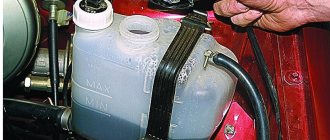When organizing fuel transportation, it is often necessary to convert the mass into liters and vice versa, including during wholesale deliveries from the manufacturing plant. Diesel fuel, like other petroleum products, is purchased in tons. In the future, for personal use, the calculation is carried out in liters. This is precisely what explains the need to transfer from one unit to another. Using the following instructions, you can easily determine how many liters are in a ton of diesel fuel of different brands.
Diesel
Diesel fuel EURO
Price:
from 35.28 ₽
- Density: 0.84
Buy online
How many liters of gasoline per 1 km?
The calculation formula used by consumption calculators is very simple: divide the displacement by the kilometer and multiply by one hundred - l/km * 100.
Interesting materials:
What can't you eat during the Nativity fast? What should you not eat if you have Prediabetes? What is not allowed on board the plane? What cannot be transported across the Hungarian border? What can't you take in luggage on a plane? What can’t be brought to Poland 2022? What cannot be imported to Poland? What cannot be imported into the USA from Russia? What is worn on the ring finger of the right hand? What should you eat to lose weight?
Formula and calculation procedure
The reason for the need to conduct mutual settlements with the supplier with units of measurement in tons is the physical properties of diesel. As a liquid, it is capable of changing its volume under the influence of temperature. To convert from one unit of measurement to another, you do not need to know many different parameters. All you need is density. Its standard indicators are given in GOST 305-2013. It varies for different brands of fuel, which can be summer, interseasonal, winter and arctic. The following values are used for calculations:
- 863.4 kg/m3 – for summer and off-season diesel brands;
- 843.4 kg/m3 – for winter brands;
- 833.5 kg/m3 – for arctic.
How many kg are in a liter of diesel fuel?
Bavarina Square, 2,
office 910 Barnaul,
Altai region, Russia
- home
- Branded fuel
- Petrochemicals Absorbents
- Gasoline for industrial purposes
- Aromatic hydrocarbons
- Petroleum toluene (methylbenzene, phenylmethane, toluene)
- Orthoxylene
- AHF (Aromatic hydrocarbon fraction)
- Alcohols
- Isobutanol
- Antioxidants
- Diethylamine
- Paint industry
- Acetone
- Octane boosters
"Apl > Diesel fuel
- Consulting
- Social activity
- Information »
- Calculators »
- Petroleum products converter
10 years of honest partnership!
Dandelion LLC was founded in May 2009 in Barnaul. Since 2012, Dandelion LLC has been the official distributor of Volzhsky Orgsintez OJSC. In 2011, Dandelion LLC employed 2 managers with 3 partners. By 2012, the number of managers increased to 3, and the number of partners to 39. At the moment, the company is a team of 18 professionals, and the number of partners is more than 270.
The main activity of the company is wholesale trade in petrochemicals and fuel additives. Our company organizes delivery by road and rail transport
The main value of the company when working with clients is not the financial side of cooperation, but the value of relationships based on openness and honest partnership!
- home
- Branded fuel
- Petrochemicals Absorbents
- Gasoline for industrial purposes
- Aromatic hydrocarbons
- Petroleum toluene (methylbenzene, phenylmethane, toluene)
- Orthoxylene
- AHF (Aromatic hydrocarbon fraction)
- Alcohols
- Isobutanol
- Antioxidants
- Diethylamine
- Paint industry
- Acetone
- Octane boosters
"Apl > Diesel fuel
- Consulting
- Social activity
Address:
656049, Russia, Altai Territory, Barnaul, Bavarina Square, 2, office 910
Telephone:
(the call is free)
Email:
This email address is being protected from spambots. You must have JavaScript enabled to view it.
State standard (GOST)
There is a GOST, according to which the density of diesel fuel should be:
- 860 kg/m3 - density of summer diesel fuel;
- 840 kg/m3 - density of winter diesel fuel;
- 830 kg/m3 - density of active diesel fuel.
These density standards must be met at a temperature of +20C. Winter fuel for diesel engines has a lower density, which means greater fluidity and the ability to not freeze in cold weather. Therefore, many drivers of diesel cars have trouble starting when they do not have time to fill the appropriate fuel in time.
Diesel fuel specific gravity standards:
- 8440 N/m3 (Newton per cubic meter) - this is for summer diesel fuel;
- 8240 N/m3 - this is for winter solarium.
What you need to know before making calculations
One of the most important indicators of diesel fuel is its density level, i.e. mass to volume ratio.
This proportion may vary depending on the following parameters:
- Fuel type – summer, winter, special arctic;
- Time of year and storage temperature;
- Natural level of moisture evaporation during long-term storage.
If accuracy is not of fundamental importance, then we can limit ourselves to data relating to the established standard for measurements and calculations.
When purchasing, the necessary information can be clarified with the manufacturer or supplier, since each tank released is pre-weighed, and the density level is determined using special equipment.
How to calculate fuel for travel distance
Calculating fuel for distance is much easier. To do this, you need three types of initial data:
- Average car fuel consumption;
- Planned travel distance;
- Price for 1 liter of fuel.
You can find out the average fuel consumption from your car's owner's manual, or determine it in a practical way (described above) using our first calculator.
Enter all this data into the appropriate fields of the second calculator and receive calculation results online: the total fuel consumption required for the travel distance, and its total cost.
| Recalculate, find out volumetric weight: physical properties. | Quantities. | Amount of kg in 1 liter, kg/liter. | For calculations, reference data was used from: | Now you can find out how much it weighs using a tool such as: | ||
| Measurement error. | — | |||||
| How many kg are in 1 liter of diesel fuel - a liter can. | We use reference data on density and specific gravity, calculating using the formula to obtain the volumetric weight. | 0.821 — 0.861 | Directory of physical properties, GOST, TU. | Liter jar. | up to 5% | — |
Liters or tons?
After studying the intricacies of converting from one unit to another, the need to move to a unified measurement system may seem quite logical. However, in reality, everything is not as simple as it might seem at first glance. The thing is that in retail sales it is more convenient to measure fuel in liters, since the volume can vary. As a result, it will be almost impossible to calculate the mass of fuel for refueling “to a full tank”. When transporting, a more important indicator is the weight of the fuel, since cars have a carrying capacity established by technical characteristics.
Having understood the peculiarities of converting diesel fuel into tons and vice versa, many buyers understand that when making such calculations, the risk of unintentional errors and deliberate fraud on the part of the supplier is quite high. However, in the vast majority of cases, customers have no alternative, and purchasing in liters remains the only available option.
You can eliminate fraud by cooperating with trusted suppliers who indicate reliable information about the mass and density of the fuel in the passport. To check, you just need to convert the actual volume into kilograms and compare it with the weight indicated on the passport. Another option is to contact , whose specialists value their reputation and do not allow violations of the terms of cooperation!
This volume is in spoons, glasses, jars, etc.
Please note that the weight is calculated based on the volume of the containers and we do not in any way guarantee that they contain the specified volume, however, for approximate measurements in everyday life, the calculated weight is quite applicable.
To determine a more accurate weight, you should use a scale!
Also, keep in mind that some substances can have a destructive effect on the indicated containers and cannot be contained in them in real life.
Tea spoon
200 pcs.
Tablespoon
55.6 pcs.
Cup
4 things.
Jar 1 l
1 PC.
Physical characteristics of diesel
Diesel fuel refers to products obtained after distillation of oil at special enterprises (refineries). The quality and composition of the finished liquid must meet strict standards. The density value is a parameter that is involved in determining the productive performance of the fuel under various conditions.
It is important to know that density demonstrates the number of kilograms of liquid in one cubic meter.
Experts know that this parameter is not constant and depends on external factors, the main one of which is the ambient temperature. A rise in the thermometer stimulates a decrease in density, and the reverse process increases the specific gravity of diesel fuel.
To obtain a specific value, a measuring device is used - a hydrometer. During the measurement process, the unit must be lowered into a container with diesel fuel. To carry out measurements in different liquids, different types of hydrometers are used. Measurements in petroleum products are carried out using models AN, ANT-1 or ANT-2 .
The hydrometer is made in the form of a glass tube, inside of which there is a graduated vertical scale. A greater degree of immersion demonstrates a lower density and vice versa.
The increased specific gravity of the liquid is a consequence of the fact that it contains heavy hydrocarbon fractions. Because of this, the high-quality operation of the internal combustion engine may decrease, because the evaporation of the liquid deteriorates and its good atomization by the nozzles is not ensured. An additional negative from the presence of a large number of heavy particles is that soot and various deposits form on the working surfaces.
Petroleum product unit calculator
The calculator is designed to calculate the conversion of liters to tons, or, knowing the price per ton, calculate the price per liter. Also perform reverse calculations. When you select a product, the density is set by default. If you manually enter the density, the calculator will give more accurate readings. Average density indicated.
Calculating the density, mass and volume of petroleum products is not very difficult, but calculating everything manually using formulas is still a significant waste of time. To quickly convert from liters to tons and make other calculations related to petroleum products, it is most convenient to use a ready-made online calculator.
How to use the petroleum unit calculator
The program is designed to quickly convert liters of petroleum products into tons, as well as to calculate the cost of a liter based on prices per ton. Naturally, it is also possible to carry out calculations in reverse order.
The main thing to consider when working with the calculator is the density of the petroleum product for which the calculation is being performed. For example, if you need to convert a liter of gasoline to tons, the user’s actions will be as follows:
- In the first form provided, indicate the type of petroleum product. Depending on the user's selection, the corresponding density of the substance will be displayed.
- In the second form, specify the volume or mass of the substance (the second value will be determined automatically based on the previously specified density of the liquid).
- In the third form, indicate the cost of a liter or ton of petroleum product, after which the program will calculate the second value.
For each of the basic types of petroleum products, standard density data have been established. In practice, the values may differ depending on the specific physical characteristics of the substance. The page with the calculator provides reference density values for various types of petroleum products at a substance temperature of 20 degrees Celsius.
Calculation example
Let's assume that it is necessary to convert 100 liters of diesel fuel into tons, and then calculate the price. Actions with the petroleum products calculator will be as follows:
- Choose summer or winter diesel fuel. For summer, the program will automatically set the value to 0.835 grams per cubic centimeter.
- Indicate the volume - 100 liters, and in the next column it will be indicated that by weight it is 0.0835 tons.
- Indicate the price per liter - for example, 45 rubles. The calculator will show how much a ton of summer diesel fuel will cost – 53,892.22 rubles.
Based on the data obtained, it will be easy to simply calculate how much you need to pay when purchasing fuel in a certain volume.
Fuel density
The density of a fuel is the amount of its mass in kilograms that fits in one cubic meter. This value is not constant and depends on the temperature of the diesel fuel, which has a bad effect on the operation of the car engine if the diesel fuel is of poor quality in terms of density. The higher the temperature of the liquid, the lower its density and vice versa. It is also a known fact that the higher the density of automobile fuel, the heavier its fractional composition. This leads to the fact that the processes of atomization and evaporation of gasoline or diesel fuel are significantly worsened, therefore, various types of deposits occur more intensively in the combustion chambers of the engine and in the fuel system, which over time increasingly complicates the movement of fuel through the system. This also contributes to the formation of carbon deposits on the engine valves.
Number of liters per 1 ton for other brands of diesel fuel
By analogy with the above calculation, you can perform calculations for the off-season, winter and arctic grades. The following data will be obtained:
- For off-season brands: 1000/863.4 · 1000 = 1158 l.
- For winter: 1000/843.4 · 1000 = 1186 l.
- For Arctic: 1000/833.5 · 1000 = 1200 l.
Calculation for other densities
The passport, which must come with diesel fuel upon delivery, gives the density at 20 °C, determined experimentally. The current value depends not only on the seasonal brand, but also on the temperature of the oil product. The lower it is, the less 1 liter will weigh, and the volume of 1 kg will increase. Density also depends on the time of year and the natural level of evaporation during storage.
A more accurate number can be determined by the specific temperature measured in the tank or other container containing the fuel. The difference of 20 °C must be multiplied by 0.0007 g/cm3, which allows the temperature difference to be taken into account. If the temperature is more than 20 °C, then the difference must be subtracted from the density specified in the passport; if less, it must be added. For example, it is required to determine it for a summer brand of diesel at 15 °C. It turns out:
(20 – 15) · 0.0007 = 0.0035 g/cm3 (or 3.5 kg/m3);
863.4 – 3.5 = 859.9 kg/m3.
At first glance, the changes in density are insignificant, but when converting kilograms into liters for a large volume of diesel fuel, the difference will be noticeable:
1000/859.9 · 1000 = 1162.2 l versus 1158 l at 20 °C.










